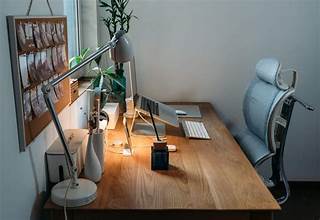Are you tired of feeling uncomfortable and achy after long hours at your desk? It’s time to revolutionize your workspace with the right desk setup! Say goodbye to back pain, wrist strain, and neck stiffness. In this blog entry, we’ll tell you the best way to make an ergonomic desert garden that will help efficiency and keep you feeling revived the entire day. Prepare to change your workplace and focus on your well-being with these simple tips for a more agreeable work area.
Table of Contents
ToggleIntroduction to the Importance of an Ergonomic Workspace
In today’s fast-paced world, most of us spend a significant amount of time sitting at a desk, whether it be for work or leisure. Nonetheless, many individuals don’t understand the effect this inactive way of life can have on our general well-being and prosperity. Unfortunately, ergonomics in the work area can prompt distress, exhaustion, and, surprisingly, long-haul outer muscle issues.
Ergonomics is the study of planning and orchestrating our current circumstances in a manner that enhances human prosperity and execution. In more straightforward terms, about making a work area meet our body’s requirements and advancing efficiency while diminishing strain and injury. An ergonomic work area goes past having an agreeable seat; it includes setting up each component of your work area to help your body’s regular development.
What is ergonomics and why is it important for a desk setup?
Ergonomics is the science of designing and arranging objects in our environment to fit the capabilities and limitations of the human body. For this situation, it alludes to making a work area that advances solace, effectiveness, and generally speaking prosperity while diminishing the gamble of outer muscle issues (MSDs). An ergonomic work area arrangement considers an individual’s body aspects, scope of movement, stance, and work propensities to limit stress on muscles, joints, ligaments, nerves, and bones.
It may not seem like a crucial aspect when setting up your desk space, but ergonomics should not be overlooked. Poorly designed workstations can lead to various health problems such as neck pain, backaches, headaches, eye strain, and even carpal tunnel syndrome. These conditions can affect productivity and cause long-term damage if left unaddressed.
The significance of ergonomics lies in its capacity to improve actual prosperity. Advancing the work area arrangement as indicated by individual requirements and inclinations, lessens weight on the body by advancing appropriate arrangement and supporting normal development designs. This prompts further developed blood course which forestalls exhaustion and distress during extended periods at your work area.
Another key benefit of ergonomics is its impact on mental health. A comfortable workspace can significantly reduce feelings of stress or tension that often come with an uncomfortable setup. It also allows for better focus as distractions from physical discomfort are eliminated.
Choosing the right desk: factors to consider
When it comes to creating an ergonomic workspace, choosing the right desk is crucial. A poorly designed desk can lead to discomfort, pain, and even long-term health issues. Therefore, it is important to consider several factors before purchasing a desk for your workspace.
1. Desk height: The main thing to consider while picking a work area is its level. In a perfect world, the work area ought to be at elbow level or somewhat lower when you are sitting in your seat with your feet level on the ground. This will guarantee a legitimate stance and lessen the burden on your neck and shoulders.
2. Adjustable features: Look for desks that offer adjustable features such as height and tilt options. This will allow you to customize the desk according to your individual needs and preferences.
3. Workspace size: Consider the amount of workspace you require before selecting a desk. If you have multiple monitors or need space for paperwork, opt for a larger desk that can accommodate all these items without making it feel cramped.
4. Type of work: Contemplate the sort of work you do every day before settling on a work area style. For instance, if you utilize a PC more often than not, a conventional rectangular-molded work area would be reasonable though if your work includes drawing or composing the hard way, consider an L-molded or corner work area which gives more surface region.
5. Storage options: Desks come with various storage options such as drawers, shelves, and cabinets. Consider how much storage space you need for your work supplies and choose a desk accordingly.
6. Design aesthetic: While functionality is key when choosing a desk for an ergonomic workspace, don’t neglect aesthetics either! After all, this will be where you spend most of your day so make sure it complements the overall design of your office space. Click here to explore the latest innovations in office furniture – find the perfect desk NZ to match your contemporary style and ergonomic needs.
7. Ease of assembly: Some desks come pre-assembled while others require assembly at home. If you are not handy with tools or don’t have much time to spare, opt for a desk that is easy to assemble.
8. Budget: Desks come in a variety of price ranges, so it’s essential to consider your budget before making a purchase. Remember, investing in a good quality desk will pay off in the long run by promoting better posture and reducing the risk of work-related injuries.
Desk height and posture: tips for maintaining proper alignment
Proper desk height and posture are crucial for maintaining a healthy and comfortable workspace. When your desk is at the right height and your body is in proper alignment, you can work more efficiently and reduce strain on your neck, shoulders, back, and wrists. The following tips will help you achieve optimal desk height and posture for a more ergonomic workspace.
1. Adjust Your Chair: The initial step to accomplishing legitimate work area level is changing your seat so your feet lay serenely on the floor with your knees twisted at a 90-degree point. This will permit you to keep up with a great stance over the day.
2. Check Your Desk Height: Your desk should be at a height where your elbows rest comfortably at a 90-degree angle when typing or using the mouse. If your desk is too high or low, it can cause strain on your arms, shoulders, and neck.
3. Use an Adjustable Desk: If possible, invest in an adjustable standing desk that allows you to change its height throughout the day. Alternating between sitting and standing can help improve circulation, reduce fatigue, and improve overall posture.
4. Keep Your Monitor at Eye Level: Many people make the mistake of placing their monitor too low on their desks, causing them to hunch over while working. Ideally, the top of your screen should be at eye level to avoid straining your neck.
5. Use a Footrest: If changing your seat doesn’t take into account legitimate foot situation on the floor, think about utilizing a hassock to help your feet. This will assist with keeping the two feet level on the ground while keeping up with appropriate arrangements in different regions of the body.
6. Position Your Keyboard Correctly: When typing or using a keyboard/mouse combination, ensure that they are placed directly in front of you with no twisting or reaching required from either hand.
7. Take Breaks to Stretch: No matter how well you set up your workstation or how perfect your posture is, it’s still important to take breaks and stretch throughout the day. This allows your body to relax and reset, reducing any strain or stiffness that may have occurred.
The role of a comfortable and supportive chair in an ergonomic workspace
A comfortable and supportive chair is an essential component of creating an ergonomic workspace. Whether you work from home or in an office, sitting for long periods in a poorly designed chair can lead to discomfort, fatigue, and even chronic pain. Hence, putting resources into a great ergonomic seat ought to be a first concern while setting up your work area. One of the principal advantages of having an agreeable and strong seat is that it advances a great stance. While sitting in an ergonomic seat, your spine is normally lined up with the backrest, offering help to your lower back. This forestalls slumping and assuages strain on the spinal plates, decreasing the gamble of creating back issues.
In addition to promoting good posture, a comfortable and supportive chair also improves blood circulation. Many traditional chairs have hard surfaces that restrict blood flow to the legs and feet, leading to numbness or tingling sensations. An ergonomic chair with proper cushioning allows for better circulation throughout the body, preventing discomfort and potential health issues.
Another important factor to consider when choosing an ergonomic chair is its adjustability. A good quality ergonomic chair should have adjustable features such as seat height, armrests, lumbar support, and tilt tension. These adjustments allow you to customize the chair according to your body’s needs and preferences, ensuring maximum comfort while working.
Organizing your workspace for efficiency and comfort
Organizing your workspace is essential for maximizing efficiency and comfort while working at your desk. A jumbled and disrupted work area can prompt interruptions, inconvenience, and, surprisingly, an actual burden on your body. In this part, we will talk about certain ways to sort out your work area to establish an ergonomic climate that advances efficiency and prosperity.
1. Start with a clean slate
The most important phase in arranging your work area is to clean any pointless things off of your work area. This incorporates papers, office supplies, and individual things that are not required for work. Keep just the basics inside the arm’s span to try not to reach or stress to get to them.
2. Utilize storage options
Invest in storage solutions such as shelves, drawers, and filing cabinets to keep your desk surface free of clutter. Use these storage options to store documents, supplies, and other items that you need but don’t need immediate access to.
3. Sort and declutter regularly
Make it a habit to sort through your desk every week or month to get rid of any unnecessary items or paperwork that may have accumulated. Keeping a clutter-free workspace will help you stay focused on the task at hand without distractions.
4. Follow the “zone” system
The zoning framework includes isolating your work area into various zones in light of the assignments you perform consistently. For instance, one zone could be committed exclusively to composing errands while another could be for PC work. This smoothes out your work process by keeping everything coordinated by capability.
5. Number or label important items
If you often find yourself searching for specific documents or supplies on your desk, consider numbering or labeling them so they are easier to locate quickly.
6. Use cable management tools
Links from hardware can undoubtedly become tangled wrecks under a work area which looks unattractive as well as represents a stumbling danger. Put resources into link-the-board devices like rope clasps or zip connections to keep links slick and coordinated.
7. Optimize lighting
Great lighting is pivotal for diminishing eye strain and advancing efficiency. Ensure your work area is situated close to a characteristic light source, and consider putting resources into a work area light with flexible brilliance settings to redo the lighting given your necessities. By following these ways to coordinate your work area, you can establish a proficient and agreeable climate that advances efficiency and prosperity. Recall to routinely clean up and change your work area depending on the situation to keep an ergonomic arrangement that turns out best for you.




